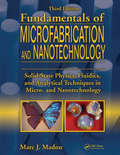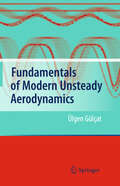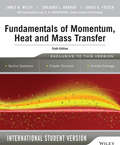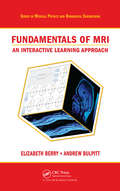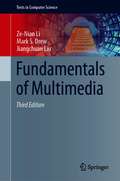- Table View
- List View
Fundamentals of Metallurgical Thermodynamics
by Santosh Kumar Sahoo Mithilesh Kumar Swapan Kumar KarakThis book highlights introduction of thermodynamics; first law, second law, third law of thermodynamics and their applications; concepts of entropy, free energies, thermodynamic equilibrium, thermodynamic activity and fugacity; Maxwell relations; Gibbs-Helmholtz equation; Clausis-Clayperon equation, etc. have been discussed in detail and made easily understandable to the undergraduate students of metallurgy. Thermodynamics involved in formation of different types of solutions (ideal, real and regular solutions) has also been discussed in detail. This book also discusses the applications of various thermodynamic properties in different metallurgical operations. At the end of each and every chapter, different types of typical related problems have also been solved.
Fundamentals of Microfabrication: The Science of Miniaturization, Second Edition
by Marc J. MadouMEMS technology and applications have grown at a tremendous pace, while structural dimensions have grown smaller and smaller, reaching down even to the molecular level. With this movement have come new types of applications and rapid advances in the technologies and techniques needed to fabricate the increasingly miniature devices that are literally changing our world.A bestseller in its first edition, Fundamentals of Microfabrication, Second Edition reflects the many developments in methods, materials, and applications that have emerged recently. Renowned author Marc Madou has added exercise sets to each chapter, thus answering the need for a textbook in this field.Fundamentals of Microfabrication, Second Edition offers unique, in-depth coverage of the science of miniaturization, its methods, and materials. From the fundamentals of lithography through bonding and packaging to quantum structures and molecular engineering, it provides the background, tools, and directions you need to confidently choose fabrication methods and materials for a particular miniaturization problem.New in the Second EditionRevised chapters that reflect the many recent advances in the fieldUpdated and enhanced discussions of topics including DNA arrays, microfluidics, micromolding techniques, and nanotechnology In-depth coverage of bio-MEMs, RF-MEMs, high-temperature, and optical MEMs.Many more links to the WebProblem sets in each chapter
Fundamentals of Microfabrication and Nanotechnology, Three-Volume Set
by Marc J. MadouNow in its third edition, Fundamentals of Microfabrication and Nanotechnology continues to provide the most complete MEMS coverage available. Thoroughly revised and updated the new edition of this perennial bestseller has been expanded to three volumes, reflecting the substantial growth of this field. It includes a wealth of theoretical and practical information on nanotechnology and NEMS and offers background and comprehensive information on materials, processes, and manufacturing options. The first volume offers a rigorous theoretical treatment of micro- and nanosciences, and includes sections on solid-state physics, quantum mechanics, crystallography, and fluidics. The second volume presents a very large set of manufacturing techniques for micro- and nanofabrication and covers different forms of lithography, material removal processes, and additive technologies. The third volume focuses on manufacturing techniques and applications of Bio-MEMS and Bio-NEMS. Illustrated in color throughout, this seminal work is a cogent instructional text, providing classroom and self-learners with worked-out examples and end-of-chapter problems. The author characterizes and defines major research areas and illustrates them with examples pulled from the most recent literature and from his own work.
Fundamentals of Microfabrication and Nanotechnology, Three-Volume Set
by Marc J. MadouNow in its third edition, Fundamentals of Microfabrication and Nanotechnology continues to provide the most complete MEMS coverage available. Thoroughly revised and updated the new edition of this perennial bestseller has been expanded to three volumes, reflecting the substantial growth of this field. It includes a wealth of theoretical and practical information on nanotechnology and NEMS and offers background and comprehensive information on materials, processes, and manufacturing options. The first volume offers a rigorous theoretical treatment of micro- and nanosciences, and includes sections on solid-state physics, quantum mechanics, crystallography, and fluidics. The second volume presents a very large set of manufacturing techniques for micro- and nanofabrication and covers different forms of lithography, material removal processes, and additive technologies. The third volume focuses on manufacturing techniques and applications of Bio-MEMS and Bio-NEMS. Illustrated in color throughout, this seminal work is a cogent instructional text, providing classroom and self-learners with worked-out examples and end-of-chapter problems. The author characterizes and defines major research areas and illustrates them with examples pulled from the most recent literature and from his own work.
Fundamentals of Microgrids: Development and Implementation
by Stephen A. RoosaMicrogrids provide a back-to-the-future solution for electrical energy systems. They provide opportunities to develop new electrical networks targeted for the needs of communities. The fourth industrial revolution is associated with the global trend toward decentralizing energy grids. Within this context, microgrids are seen as a solution to how renewable electricity can be supplied to local areas. The Fundamentals of Microgrids: Development and Implementation provides an in-depth examination of microgrid energy sources, applications, technologies, and policies. This book considers the fundamental configurations and applications for microgrids. This research-based work examines the use of microgrids as a means of meeting international sustainability goals. It focuses on questions and issues associated with microgrid topologies, development, implementation, and regulatory issues. When and why are microgrids needed? What type of microgrids are being developed and how are they configured? How are renewables linked to microgrids? How are energy storage systems used in microgrids? What workable models exist for hybrid generation solutions that apply to microgrids? How are microgrids evolving? What is an advanced or smart microgrid? These questions and more are answered in detail. Distributed energy resources are defined, standalone generation systems are described, and examples of typical microgrid configurations are provided. The key components of developing a business model for microgrid development are also considered. Microgrids offer alternatives to grid-supplied electrical power. Microgrids must have the equipment necessary to generate electricity, loads or uses for the power generated, other assets such as energy storage, plus a power management system. The technologies they use enable microgrid components to work in concert to provide electrical generation systems with enhanced benefits. Microgrids use both renewable and non-renewable generation systems to improve electrical system reliability for communities, utilities, institutions, commercial entities, and military bases. Key themes addressed in this book include microgrid technologies, drivers for microgrids, types of microgrids, and their components, configurations, and applications. Drivers for microgrids include providing local electrical supply services, resolving environmental concerns, improving resiliency, and lowering the cost of electricity. When thoughtfully designed and carefully deployed, microgrids provide more resilient energy supply systems with greater environmental benefits. FEATURES This book provides answers to the fundamental questions energy managers and other professionals want to know about the basics of microgrids. This book details the applications for microgrids and demystifies the types of microgrid architectures that are successful. It describes what microgrids are and details the basics of how they work while considering benefits of microgrids and their disadvantages. Real-world examples of functioning microgrids are provided which provide models for the development of microgrids in the future. It discusses the key considerations that must be addressed to develop a business case for microgrid development.
Fundamentals of Microgrids: Development and Implementation
by Stephen A. RoosaMicrogrids provide a back-to-the-future solution for electrical energy systems. They provide opportunities to develop new electrical networks targeted for the needs of communities. The fourth industrial revolution is associated with the global trend toward decentralizing energy grids. Within this context, microgrids are seen as a solution to how renewable electricity can be supplied to local areas. The Fundamentals of Microgrids: Development and Implementation provides an in-depth examination of microgrid energy sources, applications, technologies, and policies. This book considers the fundamental configurations and applications for microgrids. This research-based work examines the use of microgrids as a means of meeting international sustainability goals. It focuses on questions and issues associated with microgrid topologies, development, implementation, and regulatory issues. When and why are microgrids needed? What type of microgrids are being developed and how are they configured? How are renewables linked to microgrids? How are energy storage systems used in microgrids? What workable models exist for hybrid generation solutions that apply to microgrids? How are microgrids evolving? What is an advanced or smart microgrid? These questions and more are answered in detail. Distributed energy resources are defined, standalone generation systems are described, and examples of typical microgrid configurations are provided. The key components of developing a business model for microgrid development are also considered. Microgrids offer alternatives to grid-supplied electrical power. Microgrids must have the equipment necessary to generate electricity, loads or uses for the power generated, other assets such as energy storage, plus a power management system. The technologies they use enable microgrid components to work in concert to provide electrical generation systems with enhanced benefits. Microgrids use both renewable and non-renewable generation systems to improve electrical system reliability for communities, utilities, institutions, commercial entities, and military bases. Key themes addressed in this book include microgrid technologies, drivers for microgrids, types of microgrids, and their components, configurations, and applications. Drivers for microgrids include providing local electrical supply services, resolving environmental concerns, improving resiliency, and lowering the cost of electricity. When thoughtfully designed and carefully deployed, microgrids provide more resilient energy supply systems with greater environmental benefits. FEATURES This book provides answers to the fundamental questions energy managers and other professionals want to know about the basics of microgrids. This book details the applications for microgrids and demystifies the types of microgrid architectures that are successful. It describes what microgrids are and details the basics of how they work while considering benefits of microgrids and their disadvantages. Real-world examples of functioning microgrids are provided which provide models for the development of microgrids in the future. It discusses the key considerations that must be addressed to develop a business case for microgrid development.
Fundamentals of Microwave Photonics (Wiley Series in Microwave and Optical Engineering)
by V. J. Urick Keith J. Williams Jason D. McKinneyA comprehensive resource to designing and constructing analog photonic links capable of high RF performance Fundamentals of Microwave Photonics provides a comprehensive description of analog optical links from basic principles to applications. The book is organized into four parts. The first begins with a historical perspective of microwave photonics, listing the advantages of fiber optic links and delineating analog vs. digital links. The second section covers basic principles associated with microwave photonics in both the RF and optical domains. The third focuses on analog modulation formats—starting with a concept, deriving the RF performance metrics from basic physical models, and then analyzing issues specific to each format. The final part examines applications of microwave photonics, including analog receive-mode systems, high-power photodiodes applications, radio astronomy, and arbitrary waveform generation. Covers fundamental concepts including basic treatments of noise, sources of distortion and propagation effects Provides design equations in easy-to-use forms as quick reference Examines analog photonic link architectures along with their application to RF systems A thorough treatment of microwave photonics, Fundamentals of Microwave Photonics will be an essential resource in the laboratory, field, or during design meetings. The authors have more than 55 years of combined professional experience in microwave photonics and have published more than 250 associated works.
Fundamentals of Microwave Photonics (Wiley Series in Microwave and Optical Engineering)
by V. J. Urick Keith J. Williams Jason D. McKinneyA comprehensive resource to designing and constructing analog photonic links capable of high RF performance Fundamentals of Microwave Photonics provides a comprehensive description of analog optical links from basic principles to applications. The book is organized into four parts. The first begins with a historical perspective of microwave photonics, listing the advantages of fiber optic links and delineating analog vs. digital links. The second section covers basic principles associated with microwave photonics in both the RF and optical domains. The third focuses on analog modulation formats—starting with a concept, deriving the RF performance metrics from basic physical models, and then analyzing issues specific to each format. The final part examines applications of microwave photonics, including analog receive-mode systems, high-power photodiodes applications, radio astronomy, and arbitrary waveform generation. Covers fundamental concepts including basic treatments of noise, sources of distortion and propagation effects Provides design equations in easy-to-use forms as quick reference Examines analog photonic link architectures along with their application to RF systems A thorough treatment of microwave photonics, Fundamentals of Microwave Photonics will be an essential resource in the laboratory, field, or during design meetings. The authors have more than 55 years of combined professional experience in microwave photonics and have published more than 250 associated works.
Fundamentals of Modern Digital Systems
by B. R. Bannister Donald Gill WhiteheadAn ELBS/LPBB edition is available.
Fundamentals of Modern Electric Circuit Analysis and Filter Synthesis: A Transfer Function Approach
by Afshin IzadianThis textbook explains the fundamentals of electric circuits and uses the transfer function as a tool to analyze circuits, systems, and filters. The author avoids the Fourier transform and three phase circuits, since these topics are often not taught in circuits courses. General transfer functions for low pass, high pass, band pass and band reject filters are demonstrated, with first order and higher order filters explained in plain language. The author’s presentation is designed to be accessible to a broad audience, with the concepts of circuit analysis explained in basic language, reinforced by numerous, solved examples.
Fundamentals of Modern Electric Circuit Analysis and Filter Synthesis: A Transfer Function Approach
by Afshin IzadianThis textbook explains the fundamentals of electric circuits and uses the transfer function as a tool to analyze circuits, systems, and filters. The author avoids the Fourier transform, since this topic is often not taught in circuits courses. General transfer functions for low pass, high pass, band pass and band reject filters are demonstrated, with first order and higher order filters explained in plain language. The author’s presentation is designed to be accessible to a broad audience, with the concepts of circuit analysis explained in basic language, reinforced by numerous, solved examples.
Fundamentals of Modern Manufacturing: Materials, Processes, and Systems
by Mikell P. GrooverFundamentals of Modern Manufacturing: Materials, Processes, and Systems, 6th Edition, is designed for a first course or two-course sequence in Manufacturing at the junior level in Mechanical, Industrial, and Manufacturing Engineering curricula. As in preceding editions, the author's objective is to provide a treatment of manufacturing that is modern and quantitative. The book's modern approach is based on balanced coverage of the basic engineering materials, the inclusion of recently developed manufacturing processes and comprehensive coverage of electronics manufacturing technologies. The quantitative focus of the text is displayed in its emphasis on manufacturing science and its greater use of mathematical models and quantitative end-of-chapter problems.
Fundamentals of Modern Unsteady Aerodynamics
by Ülgen GülçatIn this book, the author introduces the concept of unsteady aerodynamics and its underlying principles. He provides the readers with a comprehensive review of the fundamental physics of free and forced unsteadiness, the terminology and basic equations of aerodynamics ranging from incompressible flow to hypersonics. The book also covers modern topics related to the developments made in recent years, especially in relation to wing flapping for propulsion. The book is written for graduate and senior year undergraduate students in aerodynamics and also serves as a reference for experienced researchers. Each chapter includes ample examples, questions, problems and relevant references. The treatment of these modern topics has been completely revised end expanded for the new edition. It now includes new numerical examples, a section on the ground effect, and state-space representation.
Fundamentals of Modern Unsteady Aerodynamics
by Ülgen GülçatThis book introduces the concept of unsteady aerodynamics and its underlying principles. The author provides the readers with a comprehensive review of the fundamental physics of free and forced unsteadiness, the terminology and basic equations of aerodynamics ranging from incompressible flow to hypersonics. The book also covers modern topics related to the developments made in recent years, especially in relation to wing flapping for propulsion. The book is written for graduate and senior year undergraduate students in aerodynamics and also serves as a reference for experienced researchers. Each chapter includes ample examples, questions, problems and relevant references.This 3rd edition includes a new chapter about unsteady applications related to the thrust optimization, aerodynamic stability and trim because there has been much progress in unsteady applications of the flapping wing technology. In addition, further material is presented in Appendix for evaluating the stability derivatives so that no derivation of equations is left incomplete but not overdone in the text.
Fundamentals of Modern Unsteady Aerodynamics
by Ülgen GülçatIn this textbook, the author introduces the concept of unsteady aerodynamics and its underlying principles. He provides the readers with a full review of fundamental physics of the free and the forced unsteadines, the terminology and basic equations of aerodynamics ranging from incompressible flow to hypersonics. The book also covers the modern topics concerning the developments made during the last years, especially in relation to wing flappings for propulsion. The book is written for graduate and senior year undergraduate students in Aerodynamics, and it serves as a reference for experienced researchers. Each chapter includes ample examples, questions, problems and relevant references.
Fundamentals of Momentum, Heat and Mass Transfer, 6th Edition International Student Version
by James Welty Gregory L. Rorrer David G. FosterFundamentals of Momentum, Heat, and Mass Transfer, now in its sixth edition, continues to provide a unified treatment of momentum transfer (fluid mechanics), heat transfer, and mass transfer. This new edition has been updated to include more coverage of modern topics and new applications, such as macro- and micro-scale chemical reactors. Additionally, the sixth edition focuses on an explicit problem-solving methodology that is thoroughly and consistently implemented throughout the text. It is designed for undergraduates taking transport phenomena or transfer and rate process courses.
Fundamentals of MRI: An Interactive Learning Approach (Series in Medical Physics and Biomedical Engineering)
by Elizabeth BerryFundamentals of MRI: An Interactive Learning Approach explores the physical principles that underpin the technique of magnetic resonance imaging (MRI).After covering background mathematics, physics, and digital imaging, the book presents fundamental physical principles, including magnetization and rotating reference frame. It describes how relaxati
Fundamentals of Multibody Dynamics: Theory and Applications
by Farid AmiroucheThis textbook – a result of the author’s many years of research and teaching – brings together diverse concepts of the versatile tool of multibody dynamics, combining the efforts of many researchers in the field of mechanics.
Fundamentals of Multimedia (Texts in Computer Science)
by Ze-Nian Li Mark S. Drew Jiangchuan LiuPREVIOUS EDITIONThis textbook introduces the “Fundamentals of Multimedia”, addressing real issues commonly faced in the workplace. The essential concepts are explained in a practical way to enable students to apply their existing skills to address problems in multimedia. Fully revised and updated, this new edition now includes coverage of such topics as 3D TV, social networks, high-efficiency video compression and conferencing, wireless and mobile networks, and their attendant technologies. Features: presents an overview of the key concepts in multimedia, including color science; reviews lossless and lossy compression methods for image, video and audio data; examines the demands placed by multimedia communications on wired and wireless networks; discusses the impact of social media and cloud computing on information sharing and on multimedia content search and retrieval; includes study exercises at the end of each chapter; provides supplementary resources for both students and instructors at an associated website.
Fundamentals of Multiphase Heat Transfer and Flow
by Amir Faghri Yuwen ZhangThis textbook presents a modern treatment of fundamentals of heat and mass transfer in the context of all types of multiphase flows with possibility of phase-changes among solid, liquid and vapor. It serves equally as a textbook for undergraduate senior and graduate students in a wide variety of engineering disciplines including mechanical engineering, chemical engineering, material science and engineering, nuclear engineering, biomedical engineering, and environmental engineering. Multiphase Heat Transfer and Flow can also be used to teach contemporary and novel applications of heat and mass transfer. Concepts are reinforced with numerous examples and end-of-chapter problems. A solutions manual and PowerPoint presentation are available to instructors. While the book is designed for students, it is also very useful for practicing engineers working in technical areas related to both macro- and micro-scale systems that emphasize multiphase, multicomponent, and non-conventional geometries with coupled heat and mass transfer and phase change, with the possibility of full numerical simulation.
Fundamentals of Multisite Radar Systems: Multistatic Radars and Multistatic Radar Systems
by V S ChernyakThis is an original and comprehensive monograph on the increasingly important field of Multistatic Radar Systems. The material covered includes target detection, coordinate and trajectory parameter estimation, optimum and suboptimum detectors and external interferences. The practical problems faced by those working with radar systems are considered - most algorithms are presented in a form allowing direct use in engineering practice, and many of the results can be immediately applied to information systems containing different types of sensors, not only radars. This book is the revised international edition of Chernyak's renowned Russian textbook.
Fundamentals of Multisite Radar Systems: Multistatic Radars and Multistatic Radar Systems
by V S ChernyakThis is an original and comprehensive monograph on the increasingly important field of Multistatic Radar Systems. The material covered includes target detection, coordinate and trajectory parameter estimation, optimum and suboptimum detectors and external interferences. The practical problems faced by those working with radar systems are considered - most algorithms are presented in a form allowing direct use in engineering practice, and many of the results can be immediately applied to information systems containing different types of sensors, not only radars. This book is the revised international edition of Chernyak's renowned Russian textbook.
Fundamentals of Music Processing: Audio, Analysis, Algorithms, Applications
by Meinard MüllerThis textbook provides both profound technological knowledge and a comprehensive treatment of essential topics in music processing and music information retrieval. Including numerous examples, figures, and exercises, this book is suited for students, lecturers, and researchers working in audio engineering, computer science, multimedia, and musicology.The book consists of eight chapters. The first two cover foundations of music representations and the Fourier transform—concepts that are then used throughout the book. In the subsequent chapters, concrete music processing tasks serve as a starting point. Each of these chapters is organized in a similar fashion and starts with a general description of the music processing scenario at hand before integrating it into a wider context. It then discusses—in a mathematically rigorous way—important techniques and algorithms that are generally applicable to a wide range of analysis, classification, and retrieval problems. At the same time, the techniques are directly applied to a specific music processing task. By mixing theory and practice, the book’s goal is to offer detailed technological insights as well as a deep understanding of music processing applications. Each chapter ends with a section that includes links to the research literature, suggestions for further reading, a list of references, and exercises. The chapters are organized in a modular fashion, thus offering lecturers and readers many ways to choose, rearrange or supplement the material. Accordingly, selected chapters or individual sections can easily be integrated into courses on general multimedia, information science, signal processing, music informatics, or the digital humanities.



